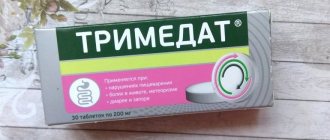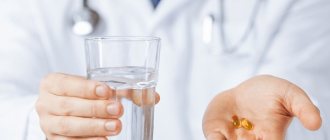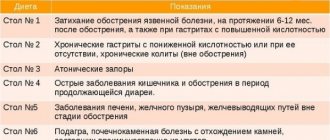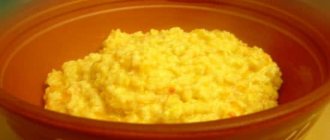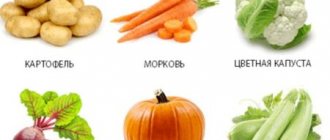Description and composition
The active substance of De-nol is bismuth tripotassium dicitrate. This subcitrate is known primarily for its astringent properties, but in fact it also exhibits antimicrobial and gastrocytoprotective properties. Among the excipients:
- corn starch;
- povidone K30;
- potassium polyacrylate;
- macrogol 6000;
- Magnesium stearate, etc.
Film-coated tablets are designed to eliminate gastro- and duodenostasis, often observed in the chronic course of the disease. With their help, the possible vicious circle of developing diseases one after another is interrupted. The use of De-nol is most effective in complex therapy of biliary-dependent pancreatitis. With its help, the lesions are covered with a protective layer and prevent the subsequent melting of the organ membranes by gastric acid.
De-nol successfully heals injured areas. In addition, it is a bactericidal agent that kills the microbe Helicobacter pylori, which infects various areas of the stomach and duodenum. The product "De-Nol" is available in tablet form. They are packaged in blisters of 8 pieces. Each cardboard box contains 112 or 56 tablets.
Description of the drug
De-Nol belongs to a number of gastroprotective agents that form a protective layer on the gastric mucosa and prevent the development of gastrointestinal pathologies.
The active ingredients of such products neutralize the acidity of pepsin, converting it into alkaline compounds. The active element of De-Nol - bismuth - reacts with necrotic proteins and forms a protective layer on the walls of the stomach, blocking the further development of pathology.
De-Nol is used for high acidity, gastritis of bacterial origin, stomach ulcers, prolonged diarrhea, irritable bowel syndrome and other pathologies.
Despite its direct purpose, the drug is prescribed for the treatment of pancreatitis. De-Nol contains active components that suppress bacteria that cause the development of gastrointestinal pathologies and have the following properties:
- anti-inflammatory;
- astringents;
- accelerate regeneration processes in damaged tissues;
- covers the affected area with a protective film.
Bactericidal properties of the drug:
- destroys the processes of decay of organic substances under the influence of enzymes in bacteria at the cellular level;
- blocks the mobility of bacteria and prevents their attachment to tissues.
The drug does not lead to addiction, so the development of resistant forms of pathology is excluded.
De-Nol is available in the form of film-coated tablets. The drug contains bismuth tripotassium dicitrate (1 tablet/120 mg) and excipients - corn starch, povidone and others. The tablets are packaged in blisters of 10 pieces and boxes of 120 tablets each.
Interesting read: Trimedat for pancreatitis, as an alternative to De-Nol.
Indications
According to the instructions, the medicine is prescribed for the treatment of the following pathologies of the digestive system:
- chronic forms of gastritis: bactericidal (associated with H. Pylori), with high acidity (hyperacidic), erosive;
- peptic ulcer of the duodenum and stomach;
- symptoms of dyspepsia: flatulence, bloating or heartburn; irritable bowel syndrome; bowel disorders;
- Ellison-Zollinger syndrome (PUD and benign neoplasm of the pancreas);
- gastroesophageal reflux disease (GERD).
That is, the instructions do not indicate that you should definitely drink De-Nol for pancreatitis. But taking De-Nol in the general treatment of pancreatitis is very important to prevent complications of therapy from other organs of the gastrointestinal tract and speedy recovery.
Side effects
The manufacturer warns about possible adverse reactions from oral administration of De-Nol. Often negative reactions are observed in case of non-compliance with the dosages prescribed by the doctor.
The main side effects include:
- Dyspeptic symptoms: nausea accompanied by vomiting, diarrhea, constipation. These phenomena are temporary and do not threaten the health and life of the patient.
- Hypersensitivity reactions: urticaria, itching, Quincke's edema.
- Encephalopathy (brain damage) develops in response to unreasonably long-term use of bismuth-containing medications.
- Painting the stool black. This phenomenon is also acceptable and poses a threat to the patient’s life.
- Acute bismuth poisoning is quite rare, but may include nausea, vomiting, diarrhea and impaired consciousness.
Features of the drug
The medication is available in the form of white tablets coated with a protective coating. The manufacturer warns that the product has an ammonia odor. This phenomenon is due to its chemical composition. A specific odor does not indicate the unsuitability of the medicine. De-Nol tablets are packaged in factory-made protective blisters, which are packaged in white and yellow boxes with the logo of the manufacturing company Astellas. The medicine has pronounced protective, antibacterial and healing properties.
According to the clinical and pharmacological classification, De-Nol is effective for the treatment of peptic ulcers and gastroesophageal reflux disease. The mechanism of action of the drug is based on the ability to bind proteins, forming a “barrier” on the surface of the mucous membrane. Under the influence of De-Nol, a protective film is formed on the damaged surface of the mucous membrane of the stomach or duodenum, which acts as a barrier to the acidic contents of the stomach.
Thanks to these features, scarring of existing defects (erosions, ulcers) is accelerated. The protective properties are based on stimulation of the synthesis of prostaglandin E2 (PGE2). When using De-Nol, the fastest possible therapeutic effect is achieved due to improved vascular circulation in the mucous membrane of the hollow organs of the gastrointestinal tract. Recent studies have established the sensitivity of H. pylori to the antimicrobial action of bismuth.
Helicobacter, in case of infection of the body, is considered the main factor in the development of ulcerative lesions. Bismuth subcitrate blocks the activity of intracellular enzymes of bacteria, which leads to their death.
Indications for use, according to the package insert from the manufacturer: ulcerative lesions of the stomach and/or duodenum; erosion of the hollow organs of the digestive tract; gastroenteropathy caused by chronic intoxication with alcohol and non-steroidal analgesics; gastritis, duodenitis, gastroduodenitis with various course options. De-Nol for pancreatitis is used as an auxiliary drug. The drug is especially effective for the treatment of biliary pancreatitis. The medication is used to prevent functional disorders of the digestive tract, which often accompany diseases of the pancreas.
Storage conditions of the drug
The drug should be stored in a dry place away from direct sunlight. It is better to store tablets in a room where the temperature does not exceed 25 degrees. Otherwise, the medicine will lose its pharmacological qualities.
Storing the drug in the refrigerator is strictly not recommended due to the excessively low temperature and high level of air humidity inside. The optimal solution would be to store the medicine in a specially designed first aid kit, out of reach of small children.
Before starting treatment, pay attention to the external condition of the tablets. There should be no mechanical damage or chips. If defects are found in capsules or tablets, it is better not to use them. If the tablets have a changed taste or smell, this becomes evidence of improper storage conditions.
Chocysto-pancreatitis is an inflammatory disease that simultaneously affects the pancreas and gallbladder. The disease is increasingly occurring in people in acute form. The symptoms show significant similarities with other diseases of the gastrointestinal tract.
The occurrence of the disease is often caused by the unfavorable influence of environmental factors, poor and irregular diet, frequent stress and impaired motor activity. According to statistics from medical institutions, women are often susceptible to the disease.
Cholecystitis and pancreatitis act as concomitant diseases. Chronic pancreatitis develops as a complication against the background of cholecystitis.
Operating principle
De-Nol contains bismuth compounds, which, when exposed to the acidic environment of the stomach, are converted into insoluble salts: bismuth oxychloride and bismuth citric acid salt. They cover the epithelial defect in the stomach due to the appearance of chelate bonds with peptides that line the affected area of the mucosa, thereby stopping the access of acid from the stomach juice, or digestive juice in the duodenum.
Also, bismuth compounds lead to disruption of metabolic processes in bacterial cells of Helicobacter pylori. Bismuth salts penetrate deeply into the membrane, disrupting its permeability. Penetrating into the cell, bismuth compounds block the work of enzymes in it. Thanks to this, microbial cells are destroyed.
Effects that De-Nol has:
- Bactericidal against Helicobacter;
- Enveloping - due to the formation of a film over the epithelial defect;
- Antacid - by reducing the activity of enzymes (pepsin, pepsinogen);
- Cytoprotective effect - stimulation of the production of prostaglandin E2, increased activity of mucus cells (cells that produce mucus), stimulation of the synthesis of epidermal growth factor in the area of its defect;
- Improves bile flow.
De-Nol improves protective processes in the tissues of the gastrointestinal tract, promoting their speedy healing. When treating pancreatitis, especially if it is associated with a violation of the outflow of bile, the drug also improves the regeneration of gland tissue and improves its secretory activity.
pharmachologic effect
This pharmaceutical product produces a bactericidal effect, relieves the manifestations of the inflammatory process and provides an astringent effect. The active elements of the drug “De-Nol” for pancreatitis, entering an acidic environment, contribute to the release of insoluble substances that settle on the gastric walls and create a kind of film. It must be taken into account that proteins and chelates attach exclusively to the affected areas of the mucous membrane. That is why after taking the drug there is no tissue irritation, and the process of regeneration of inflamed areas is significantly accelerated.
De-Nol and pancreatitis
Treating pancreatitis with De-Nol without using other medications is ineffective. But taking this medicine is very important in the complex treatment of acute and chronic types of pancreatitis, as well as in the exacerbation phase of the disease.
This is due to the fact that:
- With exacerbation of pancreatitis, which occurs as chronic, the production of pancreatic enzymes increases. They are capable of damaging the mucous membrane of the gastroduodenal tract, provoking the development of gastritis;
- Exacerbation of pancreatitis requires a “starvation” diet in the hospital for up to 5 days: patients do not eat, which creates conditions for damage to the gastric mucosa and duodenum;
- Chronic forms of pancreatitis are often associated with diseases of other parts of the gastrointestinal tract: gastroduodenitis, impaired bile outflow, disorder of motor-evacuation function;
- Pancreatitis can develop due to infection of gland tissue by Helicobacter pylori.
- Treatment of inflammation of the pancreas with De-Nol is carried out in combination with appropriate therapy aimed at eliminating exacerbations of pancreatitis. The drug accelerates the healing process, prevents the production of aggressive digestive juices, reducing their acidity and enzymatic activity, and improves the patency of the ducts of the liver and pancreas.
- These properties are used to prevent the development of gastroduodenitis during the treatment of disorders of the pancreas and to shorten the period of active treatment during exacerbations of chronic forms of the disease. It is especially effective to take De-Nol for pancreatitis if a biliary-dependent type is identified.
Treatment with traditional methods
In the complex of rehabilitation measures for chronic cholecysto-pancreatitis, traditional medicine methods are successfully used, which rehabilitate the affected organs. It is better to treat cholecystitis using traditional methods under the supervision of a doctor.
Herbal medicine is considered an effective method of treatment. This treatment of cholecystitis has long been recognized by official medicine and is widely used in the complex treatment of diseases of the pancreas and biliary system.
- Homemade medicine is prepared from one teaspoon of dried and crushed wormwood and yarrow herbs. Pour a glass of boiling water over the herb and then leave it to brew for half an hour. You should take this drug 4 times a day, half a glass.
- Prepare a tincture with wormwood - mix equal parts of wormwood herb with St. John's wort and peppermint. Pour boiling water over the herb and leave on low heat for 20 minutes. You need to drink this infusion on an empty stomach, twice a day, a full glass.
- An infusion of sage with the addition of buckthorn leaf is used. Dill and knotweed are added to the mixture. Grind the resulting mixture and mix well. Then 2 tablespoons of the resulting raw material are poured with boiling water and infused for two hours. Half a glass of ready-made chilled broth is taken in the mornings and evenings before meals. The course of treatment is at least two months. It has been found that this relieves inflammation and eliminates abdominal pain during exacerbations of pancreatitis and cholecystitis.
A simple and affordable traditional treatment method is to drink at least two liters of still water at room temperature every day.
To cleanse the gallbladder of sand, use flaxseed oil. A large amount of plant foods rich in ascorbic acid will help relieve the inflammatory process. You will need to exclude fatty meats and fish from your diet, limit oil and eggs. Careful adherence to the doctor’s recommendations and proper nutrition will allow you to forget about unpleasant symptoms for a long time.
How to drink De Nol, how effective is it? This question interests those who suffer from stomach diseases.
There are many factors that negatively affect human health. Due to poor nutrition, frequent stress, and lack of sleep, a person begins to feel pain in the stomach. In this case, De Nol tablets will help cope with the discomfort.
How to drink De Nol, how effective is it? This question interests those who suffer from stomach diseases.
There are many factors that negatively affect human health. Due to poor nutrition, frequent stress, and lack of sleep, a person begins to feel pain in the stomach. In this case, De Nol tablets will help cope with the discomfort.
Mechanism of action of the drug
Is it possible to drink De-Nol for pancreatitis if there is no gastritis? Many patients are perplexed when these pills are prescribed to them, because they do not suffer from damage to the mucous membranes of the stomach and intestines.
The medication is prescribed during an exacerbation, with the goal of avoiding future deterioration in the gastrointestinal tract. It accelerates the restoration of tissues and mucous membranes, and also increases protective functions and eliminates the inflammatory process.
When taking it, it is important to know the composition and description of the medication:
- active ingredient - bismuth tripotassium citrate;
- has an astringent, antimicrobial, gastrocytoprotective effect;
- tablets are indicated to eliminate gastro- and duodenostasis (such disorders can often be observed in patients with a chronic form of the disease);
- the affected areas are covered with a protective layer, which prevents further erosion of the mucous membranes by digestive juice;
- non-addictive and effective even with regular use;
- the active components included in the product are almost completely excreted in feces and urine.
The drug De-Nol and pancreatitis are directly related to each other. Doctors strongly recommend taking medicine with bismuth, even if you do not have gastritis or ulcerative lesions of the gastrointestinal mucosa.
It is known that the inflammatory process begins due to the penetration of bacteria into the body, and their mobility and reproduction should be stopped immediately, preventing a disorder in the functioning of the gland from developing into an even more serious disease.
Once in the gastric acidic environment, the active substances of the tablets are released, which settle specifically on the inflamed areas, creating a protective layer that does not allow germs to pass through.
Basic treatment regimens and doses
When treating pancreatic dysfunction, standard treatment regimens are followed. If the doctor has not recommended a different dosage regimen, then follow the dosage recommendations described in the instructions:
- For children, the dose is calculated depending on body weight.
- Adults take 1 tablet three times a day and one dose before going to bed.
The course of therapy is 30-60 days. Longer use is contraindicated due to the risk of bismuth accumulation in the body and the development of unwanted side reactions.
There are several basic treatment regimens:
- Take 1 tablet four times.
- Take the medicine twice, 2 pcs.
The drug is taken half an hour before a meal, washed down with plain water. Milk, sour juices, fruit drinks, compotes are incompatible with the active substance of the tablets. Their use within 30 minutes before and after taking the tablets neutralizes the therapeutic activity of the medication.
Along with De-Nol, it is recommended to take antispasmodics and anti-inflammatory drugs. Diet adherence is mandatory. New products will be allowed depending on the patient’s well-being and the course of the pathological process.
The acute course of the disease is accompanied by intense pain, diarrhea, and the presence of undigested food residues in the stool. Fermentation is disrupted, making the process of normal digestion of food difficult. Exacerbation of the chronic form requires:
- refusal to consume food and medications,
- compliance with bed rest:
- applying cold to the sore area of the body,
It is necessary to immediately call an ambulance and refrain from self-medication. De-Nol is used in a complex therapy regimen after the exacerbation has stopped.
It is recommended to refrain from taking tablets when treating patients under 4 years of age, pregnant and lactating women, and persons with severe liver and kidney dysfunction. The medicine is well tolerated. Adverse reactions occur mainly when the recommended dose is not followed.
The chronic form is accompanied by mild symptoms: periodic pain impulses, diarrhea, flatulence. Prolonged course of the disease and lack of timely medical care is fraught with destruction of the pancreas. Treatment includes taking medications with enzyme and anti-inflammatory properties. At the same time, De-Nol protects the mucous membrane of the stomach and duodenum.
In the chronic form of the disease, taking De-Nol may not be necessary. The appropriateness, dose and course of taking the drug is determined by the doctor after conducting a comprehensive diagnosis, an in-person examination and interviewing the patient.
Why do doctors prescribe this drug?
Disorders of the pancreas occur with a sharp release of enzymes, as a result of which the secretion of gastric juice increases.
De-Nol for pancreatitis is the first thing the doctor prescribes. In the very first days of an exacerbation, a person is forced to fast and take only drinks. With increased secretion of acid in the stomach, the mucous membranes also begin to become inflamed, and without the use of a relief agent, a person gets gastritis due to pancreatitis.
The tablets are capable of affecting even the deepest layers of the mucosa, and their use is indicated for:
- gastritis;
- irritable bowel syndrome,
- ulcerative processes provoked by Helicobacter Pylori bacteria.
Considering the increased secretion of acid in disorders of secretory functions, this medicine is especially appropriate when drawing up a regimen.
Can children take De-Nol for pancreatitis? Unfortunately, not only adults, but also children are susceptible to such an ailment as an inflammatory process in the pancreas. And every mother wants to know how appropriate and effective a therapeutic drug is.
The drug has virtually no age restrictions; children can take it from the age of four. In children, symptoms mainly appear between the ages of 4 and 17 years, this is due to developmental characteristics.
Rules for using the drug
The main treatment for pancreatitis is diet, especially during the acute period. De-Nol for pancreatitis is prescribed to prevent the development of stomach diseases.
With pancreatitis, the normal outflow of pancreatic enzymes is disrupted, which leads to hypersecretion of gastric juice. Large production of pepsin due to the hydrochloric acid content in it gradually destroys the gastric mucosa and causes the development of gastritis and ulcers. De-Nol prevents the occurrence of gastrointestinal diseases due to pancreatitis.
De-Nol can be used for pancreatitis in acute or chronic forms of pathology to stop the development of gastrointestinal diseases. The product restores tissue cells and mucous membranes, improves immunity and eliminates inflammation.
The classic way to take De-Nol tablets:
- Adults and children over 12 years old - 1 tablet 4 times a day or 2 tablets 2 times half an hour before meals, with a small amount of water.
- Children from 8 to 12 years old – 1 tablet 2 times a day, half an hour before meals.
- For the age group of children from 4 to 8 years, the dose is calculated based on body weight (8 mg per 1 kg of body weight per day).
De-Nol is used for 1 to 2 months. At the end of treatment, medications containing bismuth should not be used for 2 months.
The doctor individually prescribes the dosage and duration of the course of taking the drug.
Application regimen and correct dosage
The regimen for using de-nol for pancreatitis is also unique, and only by adhering to it can you achieve positive results.
While taking pills, you should exclude from your diet foods that deactivate the medication: milk, carbonated drinks, fruits and juices. The medicine should be taken with plenty of water.
At the end of the course, you need to take blood tests to find out the level of bismuth concentration in the blood. The norm is 58 µg/l.
Concomitant use with tetracyclines is not recommended. It is forbidden to take medications with a similar composition in parallel.
In combination with antibiotics, their absorption into plasma is significantly reduced, so it is not recommended to drink other pills or syrups for at least 30 minutes after De-Nol.
The drug is used as an additional remedy for disorders of the gland in both acute and chronic stages. Even though the medication has virtually no contraindications, a doctor’s recommendation is necessary before starting therapy.
It is not recommended to take the tablets for more than eight weeks, as this may result in kidney failure or an allergic reaction to the tablets.
Recommendations on how to take De-Nol for pancreatitis do not differ from standard doses of the drug:
- The medication is used from 4 years of age. The pediatric dosage for patients aged 4-8 years is calculated individually, based on the child’s weight: 8 mg/kg of the child’s weight. The resulting amount of medication is divided into two doses. The daily dose is no more than 2 tablets. The medicine is given once before bedtime;
- For children aged 8-14 years, De-Nol should be taken twice a day, 1 tablet per single dose. In this case, one of the doses should be at night;
- For adults, the medication is given four times: 1 tablet three times a day before meals, and one dose before bed.
- De-Nol should be drunk half an hour before meals with plenty of water. Do not take the medicine with juice, sparkling water, tea, or milk. These products inactivate the drug, so you should avoid taking them half an hour before drinking De-Nol and 30 minutes after.
The treatment course lasts from 1 to 2 months. Exceeding the recommended duration of treatment is undesirable in order to prevent the accumulation of bismuth salts and the development of kidney pathologies. When treating pancreatitis, it is especially important to use the cytoprotective features of De-Nol during therapeutic fasting and in the acute phase. Chronic pancreatitis, which is accompanied by enzyme deficiency, may not require the prescription of this medicine, however, the indications for taking De-Nol are determined by the doctor.
Treatment
Cholecystopancreatitis requires an integrated approach to treatment. The course consists of taking medications, following the prescribed diet, and physical therapy. Depending on the severity of the disease, a treatment regimen is selected individually. Drug treatment is prescribed: antibiotics (Cefazolin, Ampiox, Gentamicin), choleretic (Holagol, Liobil), painkillers (No-shpa, Papaverine), enzymes (Omeprazole, Creon, Mezim, Pancreatin), restoring the functioning of the gastrointestinal tract, antispasmodics (Drotaverine, Difacil ), antibacterial (Cyqualon, Oxafenamide), antacids (Almagel), anti-inflammatory drugs. The duration of the course of treatment and medications to combat cholecystopancreatitis are selected by the doctor. Self-medication is prohibited, as it can cause additional complications of the disease!
Physiotherapy is prescribed to the patient if the disease is in remission. Thanks to electrophoresis, blood circulation improves, bile production increases, and inflammatory processes decrease. In case of acute cholecystopancreatitis (pancreocholecystitis) or exacerbation of the disease, the procedures are contraindicated. Joint treatment of the disease will give a quick positive result.
Diet for cholecystopancreatitis
Compliance with dietary nutrition is an important part of treatment. Food can disrupt the functioning of the gastrointestinal tract and create additional stress on the gallbladder, liver, and kidneys. Strictly adhere to the diet rules and doctor's recommendations.
Adviсe:
- Maintain proper nutrition;
- Eat small meals;
- The diet is followed for a long time, not only during exacerbations of the disease;
- Eat only approved foods;
- Do not break your diet (for example, a small amount of smoked food can cause a relapse).
The diet menu is compiled together with the attending physician. Patients with cholecystopancreatitis are prescribed diet No. 5. The diet consists of healthy foods: dietary boiled meat, steamed fish, vegetable soups, low-fat fermented milk products, cereals, weak tea, compote, fruit juice, etc.
Prohibited products:
- Fatty, hot, spicy food;
- Smoked meats;
- Baked goods: white bread, buns;
- Sour, sweet juices;
- Products containing cocoa (chocolate);
- Garlic, onion, radish;
- Strongly brewed teas;
- Alcohol;
- Sparkling water;
- Marinades containing vinegar.
Folk remedies
Folk remedies have a beneficial effect on the digestive organs. Joint treatment with medications and folk methods will bring quick, positive results. Medicinal herbs and plants for the treatment of gastrointestinal diseases:
- Decoction of dried rose hips. 500 gr. add water, leave for 30 minutes, put on low heat, and boil for 5 minutes. Take 3 times a day, 200 ml after meals. Store the decoction in the refrigerator. Used for pancreatitis.
- Leaves of the Golden Whisker. Grind 2-3 leaves of the plant, pour 500 ml of boiling water, boil over medium heat for 10-15 minutes. Leave for 8 hours. It is recommended to drink warm tincture 3 times a day before meals, 50 ml. Course 30 days. This treatment helps relieve inflammation of the biliary tract and is used for gallbladder diseases.
- Collection of herbs: burdock, string, wormwood, chamomile flowers, calendula officinalis, sage. Mix the herbs in equal parts, pour 2 tablespoons of 100-degree boiling water into 400 ml, leave for an hour. Take 3 times a day, before meals, 100 ml. The course of treatment is 3 weeks. The collection will help cure a number of stomach diseases.
- Strawberries. Pour boiling water (250 ml) over wild strawberry roots (1 tablespoon). Let it brew for 1 hour. Drink 100 ml morning and evening. Used for cholecystitis, gastritis, and pancreatitis.
- Dill. Dill water is used for problems with the gastrointestinal tract. Pour boiling water over the dill seeds and let it brew. Drink 100 ml 3 times a day. Ready-made dill water can be purchased at the pharmacy.
- St. John's wort, motherwort, chamomile flowers, rose hips, nettle. Take equal proportions of herbs and mix. Steam a tablespoon of the collection with boiling water (250 ml). Let it brew for 6 hours. Take before meals, 100 ml 3 times a day.
- Red rowan. The difference between red rowan is its effective beneficial effect on the gastrointestinal tract. It is used as a choleretic agent; in the prevention of vitamin deficiency, dried rowan berries can be added to tea and dishes. You can prepare a rowan decoction. Grind a tablespoon of berries, pour 200 ml of boiling water, let it brew for 5 hours. Drink 100 ml morning and evening.
- Horseradish. Used as an anti-inflammatory, antibacterial, diuretic, choleretic, analgesic. The tincture improves digestive processes. Grind the horseradish root, take 1 tablespoon, pour in 100 ml of milk, simmer over low heat for 10 minutes. Cool, filter. Take throughout the day.
The traditional method should be used in treatment in combination with medications, with the permission of the attending physician.
Pharmacological interaction
For pancreatitis, De-Nol should be taken together with other groups of medications. De-Nol does not change the effectiveness of such products as:
- painkillers (No-Shpa, papaverine);
- proton pump inhibitors;
- enzyme replacement treatment (Creon, Festal);
De-Nol should not be used together with:
- Milk;
- cocoa, tea, coffee;
- sparkling water and drinks;
- juices;
- fruits;
- alcoholic drinks.
Because they inactivate bismuth salts in the drug.
De-Nol reduces the absorption of antibacterial agents, especially tetracycline, and therefore the use of these two drugs together is not recommended. If the treatment of pancreatitis requires mandatory use of tetracycline, then the doctor should explain in detail the medication regimen and adjust the dose of the antimicrobial agent.
In the treatment of pancreatitis, the complex of prescribed drugs often includes antibiotics, but drugs from the Ampicillin group are usually used.
The leading role in the treatment of pancreatitis in any phase of the course is played by a diet with the abolition of foods that are difficult to digest and require intense work of the gland: fried, smoked, sweet, fatty foods. Chronic forms of pancreatitis require replacement treatment of enzyme deficiency and enzyme supplementation.
Is De-Nol possible for pancreatitis?
Does it make sense to drink De-Nol for pancreatitis if there are no signs of gastritis? Many patients are surprised when their doctor prescribes this drug to them. However, its use can be beneficial.
The active substance of De-Nol is a complex bismuth salt (tricotassium dicitrate). This substance forms a protective film exclusively on the affected areas of the mucous membranes, excluding the growth of the affected area.
In addition, the drug is active against pathogenic microorganisms that provoke the development of the inflammatory process and the development of ulcers. The remedy works like this:
- interferes with the normal fermentation process inside bacterial cells;
- prevents the attachment of pathogenic microorganisms to the mucosa;
- limits the speed of movement of bacteria;
- penetrates deep into the mucous membrane, destroying infection at all levels.
Therefore, the main indication for the use of De-Nol is:
- hyperacid gastritis;
- erosive gastritis;
- ulcerative lesions;
- irritable bowel syndrome.
But how can the remedy help if the inflammatory process has affected the pancreas? Meanwhile, doctors often prescribe De-Nol for pancreatitis, and patient reviews indicate the effectiveness of the treatment.
Pancreatitis is a disease that affects the pancreas. This organ produces insulin and pancreatic juice, which contains enzymes necessary to digest food. These enzymes begin their work in the intestines. But with the development of pathology, enzymes do not enter the intestines, but begin their work in the gland itself, destroying its tissue.
When pancreatic enzymes are released, gastric juice is released at the same time, that is, there is an increase in the production of hydrochloric acid. Excessive juice production leads to the fact that the gastric mucosa begins to become irritated, which provokes the development of inflammation and the formation of erosions and ulcers. Therefore, the prescription of De-Nol for pancreatitis is carried out to protect the gastric mucosa and prevent the development of gastritis and the formation of ulcers.
Ostrom
Pancreatitis can be acute. In the acute course of the disease, severe girdling pain in the upper abdomen, vomiting, diarrhea are noted, and the feces contain undigested food residues. The disease is characterized by impaired fermentation, which makes it impossible for the normal digestion process to occur.
In case of acute pancreatitis, the patient requires urgent medical attention. Self-medication is strictly not recommended. Before the doctor arrives, you can take the following measures:
- do not eat or drink anything;
- do not take medications;
- lie on your back, relax your stomach;
- apply cold to the area of pain.
Taking De-Nol for acute pancreatitis makes sense during the recovery period, when the main symptoms are relieved.
Chronic
In chronic pancreatitis, the clinical picture is not so pronounced. The pathology develops gradually, manifested by periodic pain, bloating, and frequent diarrhea. The danger of the disease is that with prolonged progression of the disease, destruction of pancreatic tissue occurs.
Treatment consists of prescribing enzyme and anti-inflammatory drugs, as well as De-Nol. It is prescribed to protect the mucous membranes of the stomach and duodenum.
Pancreatitis acute and chronic
The drug is prescribed for acute and chronic forms of pancreatitis.
Acute pancreatitis begins with sharp girdle pains that cannot be tolerated, vomiting that does not bring relief, and loose stools with undigested food debris.
General weakness increases, heart rate increases, cold sweat appears.
This condition requires immediate hospitalization, as it poses a threat to the patient’s life.
Before the doctor arrives, it is necessary to take measures that will support the person and help prevent the condition from worsening:
- do not eat or drink anything, so as not to irritate the gland;
- lie down and relax your stomach to slightly reduce pain;
- apply cold to the area of pain;
- You cannot take any medications on your own, this will complicate the diagnosis, since the clinical picture of the disease will be blurred.
Chronic pancreatitis does not have pronounced symptoms. The disease develops gradually over several years, sometimes it takes up to 10 years from the onset of the disease to the appearance of the first obvious signs.
Throughout this time, a person feels pain in the upper abdomen after eating, mild nausea, bloating, and periodic diarrhea.
Prolonged continuation of the disease without proper therapy leads to the death of pancreatic tissue, and its ability to produce hormones and enzymes is lost.
In this case, the patient does not feel severe pain, sometimes there is no pain at all.
The fact that a person has chronic pancreatitis is indicated by pale and dry skin, loss of performance, fatigue, periodic stool disorders, weight loss without impaired appetite.
Therapy for chronic pancreatitis involves prescribing De-nol along with painkillers, enzymes, and vitamins.
At the same time, endocrine disorders, if any, are treated.
Interaction with other drugs
When taking De-nol, it is necessary to take into account its interaction with other drugs and substances. For example, simultaneous use of tablets with tetracycline antibiotics leads to a slowdown in the process of their penetration. You cannot include other agents containing bismuth in De-nol therapy to prevent intoxication of the body with the heavy metal.
For pancreatitis, Ermital capsules may also be prescribed.
Compatibility with alcohol is zero. Ethyl alcohol acts as an “antagonist” of De-nol. It reduces the effectiveness of the medicine and promotes the entry of bismuth into the blood, which threatens poisoning.
In what cases is taking De-Nol prohibited?
Absolute contraindications to the use of the drug De-Nol are renal failure in the stage of decompensation and individual intolerance to the components of the drug.
The pancreas is an organ of mixed secretion. If acute insufficiency of secretory sites has developed during inflammation, you should limit your intake of De-Nol.
The use of the drug in pediatric practice is limited. The minimum age for De-Nol therapy is 4 years. Such restrictions are associated with an underdeveloped swallowing reflex. Accidental inhalation of the tablet and its entry into the bronchial tree is possible.
De-Nol is incompatible with other drugs, since bismuth subcitrate reduces their absorption activity. It is also not recommended to take De-Nol during pregnancy and lactation, since there have not been enough studies on the effect of the drug on the woman and fetus.
Drug analogues
De-Nol has complete analogues - Novobismol or Vitridinol. The two drugs have the same active ingredient, indications and contraindications. The dosage for pancreatitis is similar.
Foreign analogues include Omez D, Gaviscon, Gastrofarm.
Russian-made analogues are Venter, Vikair, Vikalin. The price of analogues depends on the number of tablets in the package and the pricing policy of the pharmacy. Many patients believe that the drug Pancreatin 8000 is an analogue of De-Nol, but in reality this is not the case. Pancreatin is prescribed as replacement therapy against the background of relative or absolute exocrine pancreatic insufficiency. They take it for a long time.
Brief characteristics of several analogues:
- Venter. The active component is sucralfate, the dosage form is tablets and granules that have antiulcer properties. For pancreatitis, it is prescribed only as part of complex therapy. Should not be given to children under four years of age with severe renal impairment;
- Omez D is available in capsules. A special feature of the drug is that it contains two active ingredients - omeprazole and domperidone. Release form: capsules with a gelatin shell. Not recommended for lactation, pregnancy, or mechanical obstruction of the gastrointestinal tract.
Analogs
In cases where it is impossible to take this medication, it can be replaced with the following medications:
- "Novobismol".
- "Wakair."
- "Vitridinol."
- "Gastrofarm".
- "Vicalin".
- "Omez D"
- "Venter."
- Gaviscon.
It is necessary to take into account that each pharmacological drug has certain dosages and contraindications, so only a specialist can choose the right analogue.
Reviews from patients about the effectiveness of combined therapy
Those who have already tried the effect of De-Nol on pancreatitis speak well of it. In general, patients are satisfied with the result and action. There are, of course, some disadvantages - the price and, if for a child a package is enough for a course of treatment, then an adult has to buy two, because the dosage for adults is higher.
De-Nol is a unique remedy that can kill Helicobacter bacteria, which leads to the development of ulcers and gastritis. May bind bile acids. Side effects are minimal, since the drug is practically not absorbed into the blood.
There are many questions on the forums about the advisability of such treatment. Those who have not yet tried this remedy, not knowing what it is intended for, are trying to mislead others by speaking negatively about the medicine.
Reading the insert of the pills, and indeed in the “indications” paragraph there is no inflammation of the pancreatic gland. But it is described that the medicine helps to stop dangerous microorganisms and increased acidity, which is observed with inflammation of the pancreas.
Contraindications and side effects
Before starting treatment with the drug, you need to study what contraindications and side effects exist. Contraindications include:
- pregnancy;
- lactation;
- liver and kidney failure.
Side effects, according to the instructions for use, occur mainly only in case of overdose, so it is necessary to strictly adhere to the prescribed dosage and not exceed the duration of the course of treatment.
